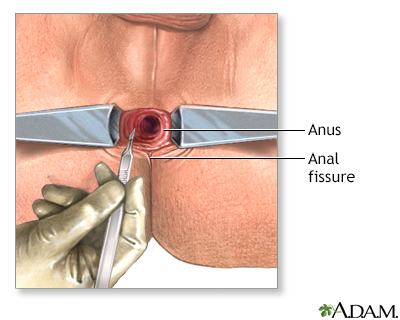Anal fissure
Fissure in ano; Anorectal fissure; Anal ulcerAn anal fissure is a small split or tear in the thin moist tissue (mucosa) lining the lower rectum (anus).
Mucosa
Mucosa is moist tissue that lines certain parts of the inside of your body. It is in your: NoseMouthLungsDigestive tractUrinary and genital tracts G...

Causes
Anal fissures are very common in infants, but they may occur at any age.
In adults, fissures may be caused by passing large, hard stools, or having diarrhea for a long time. Other factors may include:
- Decreased blood flow to the area
- Too much tension in the sphincter muscles that control the anus
The condition affects males and females equally. Anal fissures are also common in women after childbirth and in people with Crohn disease.
Crohn disease
Crohn disease is a disease where parts of the digestive tract become inflamed. It most often involves the lower end of the small intestine and the be...

Symptoms
An anal fissure can be seen as a crack in the anal skin when the area is stretched slightly. The fissure is almost always in the middle. Anal fissures may cause painful bowel movements and bleeding. There may be blood on the outside of the stool or on the toilet paper (or baby wipes) after a bowel movement.
Symptoms may begin suddenly or develop slowly over time.
Exams and Tests
Your health care provider will perform a rectal exam and look at the anal tissue. Other medical tests that may be done include:
Rectal exam
A digital rectal exam is an exam of the lower rectum. Your health care provider uses a gloved, lubricated finger to check for any abnormal findings....

-
Anoscopy -- examination of the anus, anal canal, and lower rectum
Anoscopy
Anoscopy is a method to look at the: AnusAnal canalLower rectum
 ImageRead Article Now Book Mark Article
ImageRead Article Now Book Mark Article -
Sigmoidoscopy -- examination of the lower part of large intestine
Sigmoidoscopy
Sigmoidoscopy using a flexible scope is a procedure used to see inside the sigmoid colon and rectum. The sigmoid colon is the area of the large inte...
 ImageRead Article Now Book Mark Article
ImageRead Article Now Book Mark Article -
Biopsy -- removal of rectal tissue for examination
Biopsy
A rectal biopsy is a procedure to remove a small piece of tissue from the rectum for examination.
 ImageRead Article Now Book Mark Article
ImageRead Article Now Book Mark Article -
Colonoscopy -- examination of the colon
Colonoscopy
A colonoscopy is an exam that views the inside of the colon (large intestine) and rectum, using a tool called a colonoscope. The colonoscope has a sm...
 ImageRead Article Now Book Mark Article
ImageRead Article Now Book Mark Article
Treatment
Most fissures heal on their own and do not need treatment.
To prevent or treat anal fissures in infants, be sure to change diapers often and clean the area gently.
CHILDREN AND ADULTS
Worrying about pain during a bowel movement may cause a person to avoid them. But not having bowel movements will only cause the stools to become even harder, which can make the anal fissure worse.
Prevent hard stools and constipation by:
- Making dietary changes -- eating more fiber or bulk, such as fruits, vegetables, and grains
Bulk
Fiber is a substance found in plants. Dietary fiber, which is the type of fiber you can eat, is found in fruits, vegetables, and grains. It is an i...
 ImageRead Article Now Book Mark Article
ImageRead Article Now Book Mark Article - Drinking more fluids
- Using stool softeners
Ask your provider about the following ointments or creams to help soothe the affected skin:
- Numbing cream, if pain interferes with normal bowel movements
- Petroleum jelly
- Zinc oxide, 1% hydrocortisone cream, Preparation H, and other products
A sitz bath is a warm water bath used for healing or cleansing. Sit in the bath 2 to 3 times a day for 10 to 15 minutes each time. The water should cover only the hips and buttocks.
Sitz bath
A sitz bath is a warm water bath used for healing or cleansing purposes. You sit in the bath. The water covers only your hips and buttocks. The wa...

If the anal fissures do not go away with home care methods, treatment may involve:
- Botulinum toxin injections into the muscle in the anus (anal sphincter)
- Minor surgery to relax the anal muscle
- Prescription creams, such as nitrates or calcium channel blockers, applied over the fissure to help relax the muscles
Outlook (Prognosis)
Anal fissures often heal quickly without any more problems.
People who develop fissures once are more likely to have them in the future.
References
Downs JM, Kulow B. Anal diseases. In: Feldman M, Friedman LS, Brandt LJ, eds. Sleisenger and Fordtran's Gastrointestinal and Liver Disease. 11th ed. Philadelphia, PA: Elsevier; 2021:chap 129.
Hyman N, Umanskiy K. Anus. In: Townsend CM Jr, Beauchamp RD, Evers BM, Mattox KL, eds. Sabiston Textbook of Surgery. 21st ed. St Louis, MO: Elsevier; 2022:chap 53.
Kliegman RM, St. Geme JW, Blum NJ, et al. Surgical conditions of the anus and rectum. In: Kliegman RM, St. Geme JW, Blum NJ, et al, eds. Nelson Textbook of Pediatrics. 22nd ed. Philadelphia, PA: Elsevier; 2025:chap 392.
-
Rectum - illustration
The rectum is the final portion of the large intestine. It empties stool from the body through the anus.
Rectum
illustration
-
Anal fissure - series
Presentation
Review Date: 5/29/2024
Reviewed By: Debra G. Wechter, MD, FACS, General Surgery Practice Specializing in Breast Cancer, Virginia Mason Medical Center, Seattle, WA. Also reviewed by David C. Dugdale, MD, Medical Director, Brenda Conaway, Editorial Director, and the A.D.A.M. Editorial team.








